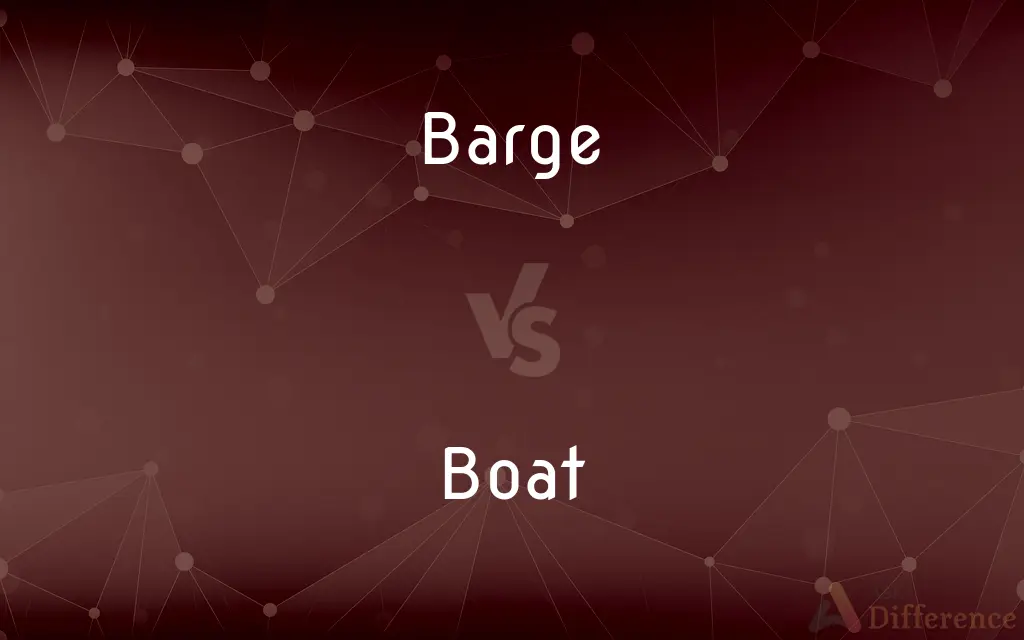Barge vs. Boat — What's the Difference?
By Maham Liaqat & Urooj Arif — Updated on April 20, 2024
A barge is a flat-bottomed vessel primarily for transporting goods on rivers and canals, typically unpowered and towed, while a boat is a smaller, more general term for watercraft used for various purposes including transport, recreation, and fishing.

Difference Between Barge and Boat
Table of Contents
ADVERTISEMENT
Key Differences
Barges are designed for the specific purpose of carrying heavy loads on inland waterways, often relying on other vessels or mechanical means for propulsion. In contrast, boats are versatile, covering a wide range of sizes and types, and are generally self-powered, equipped for personal or commercial use.
Barges often lack their own power and require tugs or towboats to move them, which makes them ideal for transporting large volumes of bulk materials economically over water. Whereas, boats can navigate a variety of water bodies, from small lakes to open seas, and are equipped with their own means of propulsion like motors or sails.
The design of a barge is very much focused on maximizing capacity and stability, with flat bottoms to easily navigate shallow waters. Boats, however, come in various shapes and designs suited to their specific functions, whether it's fishing, leisure cruising, or competitive sailing.
Operational areas for barges are typically restricted to enclosed water systems like canals and rivers due to their design and lack of mobility. On the other hand, boats are more adaptable and can be found anywhere from small ponds to the ocean, depending on their design and build.
In terms of usage, barges are crucial in commercial sectors, particularly in the transportation of commodities such as coal, grain, and ores. Boats serve a broader spectrum of purposes, from commercial activities like fishing and tours to personal and recreational use such as sailing and watersports.
ADVERTISEMENT
Comparison Chart
Definition
A flat-bottomed vessel for transporting goods, typically unpowered.
A small, versatile watercraft for various uses.
Propulsion
Usually unpowered, towed by other vessels.
Self-powered, with motors or sails.
Design Purpose
Maximizing cargo capacity and stability.
Varied, depending on use (transport, recreation, etc.).
Operating Environment
Rivers, canals, enclosed waterways.
Oceans, rivers, lakes, all water bodies.
Usage
Commercial transport of bulk goods.
Commercial, personal, recreation.
Compare with Definitions
Barge
A flat-bottomed vessel used mainly for bulk cargo transport on inland waters.
The barge carried tons of wheat down the Mississippi River.
Boat
Comes in various forms and sizes depending on purpose.
From small rowboats to larger sailing boats, each is designed for specific water activities.
Barge
Often unpowered and towed or pushed by a tugboat.
A tugboat was used to navigate the barge through the narrow canal.
Boat
Can operate in diverse water environments.
Boats are used from quiet ponds to open sea fishing.
Barge
Ideal for transporting large volumes economically.
Barges are essential for transporting coal efficiently along rivers.
Boat
Often equipped for personal use and convenience.
Her new boat was equipped with the latest fishing technology for deep-sea excursions.
Barge
Used extensively in commercial shipping and logistics.
The shipping company used barges to keep transportation costs low.
Boat
Used for both recreational and commercial purposes.
Tourist boats offer scenic views along the coastline.
Barge
Limited to calm, sheltered waters due to design.
Barges operate primarily on rivers and canals, avoiding open seas.
Boat
A small vessel capable of traveling on water, typically self-propelled.
He used his fishing boat on the lake every weekend.
Barge
A barge is a shoal-draft flat-bottomed boat, built mainly for river and canal transport of bulk goods. Originally barges were towed by draft horses on an adjacent towpath.
Boat
A boat is a watercraft of a large range of types and sizes, but generally smaller than a ship, which is distinguished by its larger size, shape, cargo or passenger capacity, or its ability to carry boats. Small boats are typically found on inland waterways such as rivers and lakes, or in protected coastal areas.
Barge
A long, large, usually flatbottom boat for transporting freight that is generally unpowered and towed or pushed by other craft.
Boat
A relatively small, usually open craft of a size that might be carried aboard a ship.
Barge
A large, open pleasure boat used for parties, pageants, or formal ceremonies.
Boat
An inland vessel of any size.
Barge
A powerboat reserved for the use of an admiral.
Boat
A ship or submarine.
Barge
To carry by barge.
Boat
A dish shaped like a boat
A sauce boat.
Barge
To move about clumsily.
Boat
To travel by boat.
Barge
To intrude or interrupt, especially rudely
Barged into the meeting.
Boat
To ride a boat for pleasure.
Barge
A large flat-bottomed towed or self-propelled boat used mainly for river and canal transport of heavy goods or bulk cargo.
Boat
To transport by boat.
Barge
A richly decorated ceremonial state vessel propelled by rowers for river processions.
Boat
To place in a boat.
Barge
A large flat-bottomed coastal trading vessel having a large spritsail and jib-headed topsail, a fore staysail and a very small mizen, and having leeboards instead of a keel.
Boat
A craft used for transportation of goods, fishing, racing, recreational cruising, or military use on or in the water, propelled by oars or outboard motor or inboard motor or by wind.
Barge
One of the boats of a warship having fourteen oars
Boat
(poker slang) A full house.
Barge
The wooden disk in which bread or biscuit is placed on a mess table.
Boat
A vehicle, utensil, or dish somewhat resembling a boat in shape.
A stone boat;
A gravy boat
Barge
(US) A double-decked passenger or freight vessel, towed by a steamboat.
Boat
(chemistry) One of two possible conformations of cyclohexane rings (the other being chair), shaped roughly like a boat.
Barge
A large omnibus used for excursions.
Boat
The refugee boats arriving in Australian waters, and by extension, refugees generally.
Barge
To intrude or break through, particularly in an unwelcome or clumsy manner.
Boat
(intransitive) To travel by boat.
Barge
(transitive) To push someone.
Boat
(transitive) To transport in a boat.
To boat goods
Barge
A pleasure boat; a vessel or boat of state, elegantly furnished and decorated.
Boat
(transitive) To place in a boat.
To boat oars
Barge
A large, roomy boat for the conveyance of passengers or goods; as, a ship's barge; a charcoal barge.
Boat
A small open vessel, or water craft, usually moved by cars or paddles, but often by a sail.
Barge
A large boat used by flag officers.
Boat
Hence, any vessel; usually with some epithet descriptive of its use or mode of propulsion; as, pilot boat, packet boat, passage boat, advice boat, etc. The term is sometimes applied to steam vessels, even of the largest class; as, the Cunard boats.
Barge
A double-decked passenger or freight vessel, towed by a steamboat.
Boat
A vehicle, utensil, or dish, somewhat resembling a boat in shape; as, a stone boat; a gravy boat.
Barge
A large omnibus used for excursions.
Boat
To transport in a boat; as, to boat goods.
Barge
A flatbottom boat for carrying heavy loads (especially on canals)
Boat
To place in a boat; as, to boat oars.
Barge
Push one's way;
She barged into the meeting room
Boat
To go or row in a boat.
I boated over, ran my craft aground.
Barge
Transport by barge on a body of water
Boat
A small vessel for travel on water
Boat
A dish (often boat-shaped) for serving gravy or sauce
Boat
Ride in a boat on water
Common Curiosities
Why are barges flat-bottomed?
Barges are flat-bottomed to enhance stability and enable them to carry heavy loads through shallow waters without the risk of tipping over.
Are all barges unpowered?
While many barges are unpowered and need to be towed, some are equipped with their own propulsion systems for better maneuverability.
What makes a boat suitable for open seas?
Boats designed for open seas are typically sturdier, with deeper hulls and often equipped with navigation and safety equipment to handle the conditions.
What is the main function of a barge?
The main function of a barge is to transport large quantities of goods along inland waterways economically.
Can boats be used for transporting goods?
Yes, boats can transport goods, but they are more commonly used for smaller scale or less bulky items compared to barges.
What safety measures are essential for boat operation?
Essential safety measures for boat operation include wearing life jackets, having communication equipment, understanding navigational rules, and weather awareness.
Can barges be used for anything besides cargo?
Barges are also used for specialized purposes like serving as floating platforms for fireworks, stages for events, or as bases for heavy equipment.
What types of boats are there?
Types of boats include fishing boats, sailboats, speedboats, pontoons, and many others, each designed for specific activities.
How do barges and boats differ in their construction?
Barges are primarily built to maximize cargo space and stability, while boats are constructed with a variety of designs to suit specific needs like speed, stability, or capacity.
Are there any environmental considerations with using barges?
Barges are considered environmentally friendly modes of transport due to their capacity to move large volumes of goods with relatively low fuel consumption compared to road transport.
What role do boats and barges play in global commerce?
Boats and barges play critical roles in global commerce, with barges essential for inland cargo transport and boats used for a variety of commercial tasks including fishing, transport, and tourism.
Can a boat serve as a recreational vessel?
Yes, boats are widely used for recreation, including sailing, motorboating, kayaking, and more.
How are boats and barges adapted for their specific functions?
Boats and barges are adapted through design specifics like hull shape, material choice, and propulsion type to meet the requirements of their functions efficiently.
What is the typical lifespan of a boat compared to a barge?
The lifespan of both boats and barges can vary widely depending on their construction, maintenance, and usage, but both can serve reliably for decades if properly maintained.
How do barges impact water traffic in busy channels?
Barges can significantly impact water traffic in busy channels as their size and slow maneuverability require careful coordination and planning.
Share Your Discovery

Previous Comparison
Unliveable vs. Unlivable
Next Comparison
Dependent vs. DependedAuthor Spotlight
Written by
Maham LiaqatCo-written by
Urooj ArifUrooj is a skilled content writer at Ask Difference, known for her exceptional ability to simplify complex topics into engaging and informative content. With a passion for research and a flair for clear, concise writing, she consistently delivers articles that resonate with our diverse audience.














































